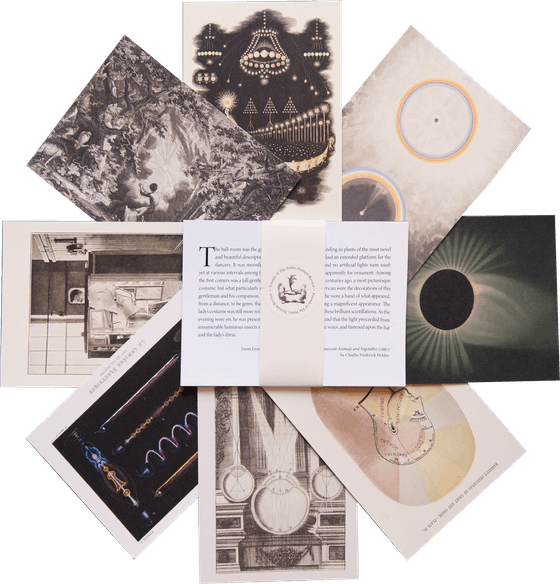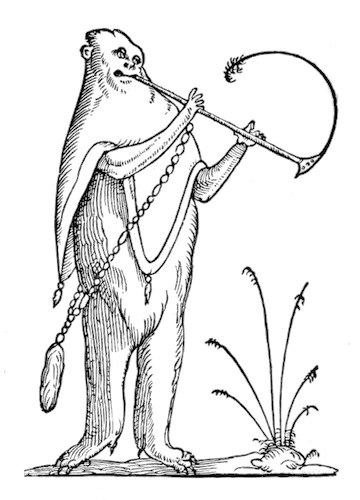
EssaysCulture & History

Propagating Propaganda: Franklin Barrett’s Red, White, and Blue Liberty Bond Carp
Toward the end of World War I, as the US peddled hard its Liberty Bonds for the war effort, goldfish dealer Franklin Barrett bred a stars-and-stripes-colored carp: a living, swimming embodiment of patriotism. Laurel Waycott uncovers the story of this “Liberty Bond Fish” and the wider use of animals in propaganda of the time. more

During the summer of 1895, in a Brooklyn park, there was a cotton plantation complete with five hundred Black workers reenacting slavery. Dorothy Berry uncovers the bizarre and complex history of Black America, a theatrical production which revealed the conflicting possibilities of self-expression in a racist society. more

Postures of Transport: Sex, God, and Rocking Chairs
What if chairs had the ability to shift our state of consciousness, transporting the imagination into distant landscapes and ecstatic experiences, both religious and erotic? In an essay about the British and American fascination with rocking chairs and upholstery springs in the 19th century, Hunter Dukes discovers how simple furniture technologies allowed armchair travelers to explore worlds beyond their own. more

As the French Revolution entered its most radical years, there emerged in print a recurring figure, the collective power of the people expressed as a single gigantic body — a king-eating Colossus. Samantha Wesner traces the lineage of this nouveau Hercules, from Erasmus Darwin’s Bastille-breaking giant to a latter incarnation in Mary Shelley’s Frankenstein. more

Lord of Misrule: Thomas Morton’s American Subversions
When we think of early New England, we tend to picture stern-faced Puritans and black-hatted Pilgrims, but in the same decade that these more famous settlers arrived, a man called Thomas Morton founded a very different kind of colony — a neo-pagan experiment he named Merrymount. Ed Simon explores the colony’s brief existence and the alternate vision of America it represents. more
%3B_two_fruiting_bodie_Wellcome_V0043330 copy.jpg?width=600&height=1200)
Fungi, Folklore, and Fairyland
From fairy-rings to Lewis Carroll’s Alice, mushrooms have long been entwined with the supernatural in art and literature. What might this say about past knowledge of hallucinogenic fungi? Mike Jay looks at early reports of mushroom-induced trips and how one species in particular became established as a stock motif of Victorian fairyland. more

Eastern Sports and Western Bodies: The “Indian Club” in the United States
Although largely forgotten today, exercise by club swinging was all the rage in the 19th century. Daniel Elkind explores the rise of the phenomenon in the US, and how such efforts to keep trim and build muscle were inextricably entwined with the history of colonialism, immigration, and capitalist culture. more

“Theire Soe Admirable Herbe”: How the English Found Cannabis
In the 17th century, English travelers, merchants, and physicians were first introduced to cannabis, particularly in the form of bhang, an intoxicating edible which had been getting Indians high for millennia. Benjamin Breen charts the course of the drug from the streets of Machilipatnam to the scientific circles of London. more

In the 21st-century, infographics are everywhere. In the classroom, in the newspaper, in government reports, these concise visual representations of complicated information have changed the way we imagine our world. Susan Schulten explores the pioneering work of Emma Willard (1787–1870), a leading feminist educator whose innovative maps of time laid the groundwork for the charts and graphics of today. more

Images have long provided a means of protesting political regimes bent on censoring language. In the 1830s a band of French caricaturists, led by Charles Philipon, weaponized the innocent image of a pear to criticize the corrupt and repressive policies of King Louis-Philippe. Patricia Mainardi investigates the history of this early 19th-century meme. more

Loie Fuller and the Serpentine
With her “serpentine dance” — a show of swirling silk and rainbow lights — Loie Fuller became one of the most celebrated dancers of the fin de siècle. Rhonda K. Garelick explores Fuller’s unlikely stardom and how her beguiling art embodied the era’s newly blurred boundaries between human and machine. more

The Myth of Blubber Town, an Arctic Metropolis
Though the 17th-century whaling station of Smeerenburg was in reality, at its height, just a few dwellings and structures for processing blubber, over the decades and centuries a more extravagant picture took hold — that there once had stood, defying its far-flung Arctic location, a bustling urban centre complete with bakeries, churches, gambling dens, and brothels. Matthew H. Birkhold explores the legend. more

H. G. Wells and the Uncertainties of Progress
In addition to the numerous pioneering works of science fiction by which he made his name, H. G. Wells also published a steady stream of non-fiction meditations, mainly focused on themes salient to his stories: the effects of technology, human folly, and the idea of progress. As Peter J. Bowler explores, for Wells the notion of a better future was riddled with complexities. more

Lustucru: From Severed Heads to Ready-Made Meals
Jé Wilson charts the migration of the Lustucru figure through the French cultural imagination — from misogynistic blacksmith bent on curbing female empowerment, to child-stealing bogeyman, to jolly purveyor of packaged pasta. more

Of all the things described in William of Rubruck’s account of his travels through 13th-century Asia, perhaps none is so striking as the remarkably ornate fountain he encountered in the Mongol capital which — complete with silver fruit and an angelic automaton — flowed with various alcoholic drinks for the grandson of Genghis Khan and guests. Devon Field explores how this Silver Tree of Karakorum became a potent symbol, not only of the Mongol Empire’s imperial might, but also its downfall. more

Progress in Play: Board Games and the Meaning of History
Players moving pieces along a track to be first to reach a goal was the archetypal board game format of the 18th and 19th centuries. Alex Andriesse looks at one popular incarnation in which these pieces progress chronologically through history itself, usually with some not-so-subtle ideological, moral, or national ideal as the object of the game. more

Divining the Witch of York: Propaganda and Prophecy
Said to be spawn of the devil himself and possessed with great powers of prophetic insight, Mother Shipton was Yorkshire’s answer to Nostradamus. Ed Simon looks into how, regardless of whether this prophetess witch actually existed or not, the legend of Mother Shipton has wielded great power for centuries — from the turmoil of Tudor courts, through the frictions of civil war, to the spectre of Victorian apocalypse. more

Five hundred years ago in July, a strange mania seized the city of Strasbourg. Citizens by the hundred became compelled to dance, seemingly for no reason — jigging trance-like for days, until unconsciousness or, in some cases, death. Ned Pennant-Rea on one of history’s most bizarre events. more

Early Modern Memes: The Reuse and Recycling of Woodcuts in 17th-Century English Popular Print
Expensive and laborious to produce, a single woodcut could be recycled to illustrate scores of different ballads, each new home imbuing the same image with often wildly diverse meanings. Katie Sisneros explores this interplay of repetition, context, and meaning, and how in it can be seen a parallel to meme culture of today. more
Iconology of a Cardinal: Was Wolsey Really so Large?
Characterised as manipulative, power-hungry, and even an alter rex, Henry VIII’s right-hand man Cardinal Thomas Wolsey has been typically depicted with a body mass to rival his political weight. Katherine Harvey asks if he was really the glutton of popular legend, and what such an image reveals about the link between the body, reputation, and power in Tudor England. more

Made in Taiwan? How a Frenchman Fooled 18th-Century London
Benjamin Breen on the remarkable story of George Psalmanazar, the mysterious Frenchman who successfully posed as a native of Formosa (now modern Taiwan) and gave birth to a meticulously fabricated culture with bizarre customs, exotic fashions, and its own invented language. more

Illustrating Carnival: Remembering the Overlooked Artists Behind Early Mardi Gras
For more than 150 years the city of New Orleans has been known for the theatricality and extravagance of its Mardi Gras celebrations. Allison C. Meier looks at the wonderfully ornate float and costume designs from Carnival’s “Golden Age” and the group of New Orleans artists who created them. more

Pods, Pots, and Potions: Putting Cacao to Paper in Early Modern Europe
Christine Jones explores the different ways the cacao tree has been depicted through history — from 16th-century codices to 18th-century botanicals — and what this changing iconography reveals about cacao’s journey into European culture. more

Brief Encounters with Jean-Frédéric Maximilien de Waldeck
Not a lot concerning the artist, erotic publisher, explorer, and general enigma Count de Waldeck can be taken at face value, and this certainly includes his fanciful representations of ancient Mesoamerican culture which — despite the exquisite brilliance of their execution — run wild with anatopistic elephants and suspicious architecture. Rhys Griffiths looks at the life and work of one of the 19th century’s most mysterious and eccentric figures. more


